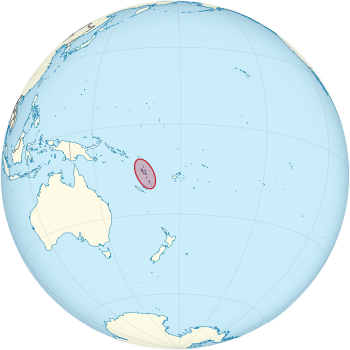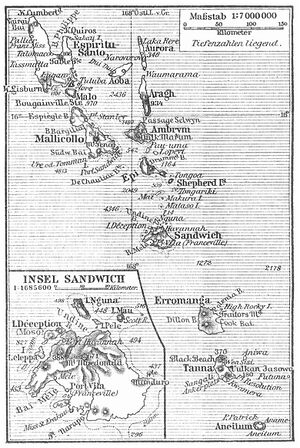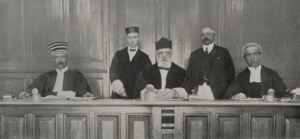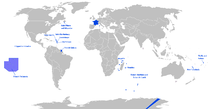نيو هبريدز
New Hebrides Condominium Condominium des Nouvelles-Hébrides | |||||||||
|---|---|---|---|---|---|---|---|---|---|
| 1906–1980 | |||||||||
 | |||||||||
| العاصمة | Port Vila | ||||||||
| اللغات المشتركة | English, French, Bislama | ||||||||
| الحكومة | |||||||||
| Resident Commisoner | |||||||||
| التشريع | Representative Assembly (1975–1980) | ||||||||
| التاريخ | |||||||||
• تأسست | 20 October 1906 | ||||||||
| 30 July 1980 | |||||||||
| العملة | New Hebrides franc, Australian dollar | ||||||||
| |||||||||
New Hebrides, officially the New Hebrides Condominium (فرنسية: Condominium des Nouvelles-Hébrides) and named after the Hebrides Scottish archipelago, was the colonial name for the island group in the South Pacific Ocean that is now Vanuatu. Native people had inhabited the islands for three thousand years before the first Europeans arrived in 1606 from a Spanish expedition led by Portuguese navigator Pedro Fernandes de Queirós. The islands were named by Captain James Cook in 1774 and subsequently colonised by both the British and the French.
The two countries eventually signed an agreement making the islands an Anglo-French condominium that provided for joint sovereignty over the archipelago with two parallel administrations, one British, one French.[1] In some respects, that divide continued even after independence, with schools teaching in either one language or the other. The condominium lasted from 1906 until 1980, when New Hebrides gained its independence as the Republic of Vanuatu.
Politics and economy
New Hebrides was a rare form of colonial territory in which sovereignty was shared by two powers, Britain and France, instead of being exercised by just one. Under the condominium there were three separate governments – one French, one British, and one joint administration that was partially elected after 1975, when elections to the New Hebrides Condominium Representative Assembly took place.[2]
The French and British governments were called residencies, each headed by a resident appointed by the metropolitan government. The residency structure greatly emphasised dualism, with both consisting of an equal number of French and British representatives, bureaucrats and administrators. Every member of one residency always had an exact mirror opposite number on the other side whom they could consult. The symmetry between the two residencies was almost exact.
The joint government consisted of both local and European officials. It had jurisdiction over the postal service, public radio station, public works, infrastructure, and censuses, among other things. The two main cities of Luganville and Port Vila also had city councils, but these did not have a great deal of authority.[مطلوب توضيح]
While initial settlers were predominantly British living in Australia, the late 19th century saw an influx of French. Within a few decades, there were twice as many French on the islands as there were British, prompting a multitude of petitions to cede power to either the French or the British. Despite this, the two nations came together to form a condominium, a specialised form of government where both nations would have all of their own administrations and jointly rule the islands. The only place they came together was in the Joint Court. As Mander describes, "The Joint Court was the key to the situation and much was to depend upon it….Three judges–one British, one French, and the third nominated by the King of Spain–were to comprise the court."[3] This meant convictions in court were chosen based on either British or French law, depending on the circumstances.
Other than the Joint Court, everything existed in pairs. "Cynics called the Condominium 'the Pandemonium', as the dual administration produced amazing duplication. There were two police forces with their own laws, including road laws, two health services, two education systems, two currencies, and two prison systems."[4] Additionally, there were separate British and French governments, which meant two immigration policies, two courts (apart from the Joint Court), and two corporation laws. Inhabitants of the islands were given the choice of which government they wanted to be ruled by. As Miles put it, "The result was an inevitable clash of foreign policy and colonial mentality."[5]
Local people could choose whether to be tried under the English common law or the French civil law. Visitors could choose which immigration rules to enter under. Nationals of one country could set up corporations under the laws of the other. In addition to these two legal systems, a third Native Court existed to handle cases involving Melanesian customary law. There was also a Joint Court, composed of British and French judges. The President of the Joint Court was appointed by the King of Spain until 1939 when the post was abolished after the retirement of the last President, partly due to the abolition of the Spanish monarchy in 1931.[6]
There were two prison systems to complement the two court systems. The police force was technically unified but consisted of two chiefs and two equal groups of officers wearing two different uniforms. Each group alternated duties and assignments.
Language was a serious barrier to the operation of the naturally inefficient system, as all documents had to be translated once to be understood by one side, then the response translated again to be understood by the other, though Bislama creole represented an informal bridge between the British and the French camps.
The condominium was not beneficial for Ni-Vanuatu, as they were "...officially stateless. [For instance,] To travel abroad, they needed an identifying document signed by both the British and the French resident commissioners."[4] Inevitably, that led to discontent across the islands, with a multitude of revolutionary groups forming in an attempt to create agency and self-government for themselves.
During the Second World War, approximately 10,000 Ni-Vanuatu men served in the Vanuatu Labor Corps, a labor battalion of the United States Armed Forces. They provided logistical support to the Allied war effort during the Guadalcanal Campaign. The mass participation of Ni-Vanuatu men in the Labor Corps had a significant effect on the John Frum movement, giving it the characteristics of a cargo cult.[7]
Self-government
New Hebrides became internally self-governing in January 1978.[8]
Chief ministers of the New Hebrides Condominium
- George Kalsakau, November 1977 - December 1978
- Gérard Leymang, December 1978 - November 1979
- Walter Lini, November 1979 - July 1980
See also
- British Empire
- French colonial empire
- List of resident commissioners of the New Hebrides
- Coconut War
- Postage stamps and postal history of Vanuatu
- History of Vanuatu
References
- Notes
- ^ Blais, Hélène (2019). "Sharing Colonial Sovereignty? The Anglo-French Experience of the New Hebrides Condominium, 1880s–1930s". In Fichter, James R. (ed.). British and French Colonialism in Africa, Asia and the Middle East. Cambridge Imperial and Post-Colonial Studies Series (in الإنجليزية). Springer International Publishing. pp. 225–247. doi:10.1007/978-3-319-97964-9_10. ISBN 9783319979649. S2CID 201397581.
- ^ "Vanuatu - a brief history from 12 - Vanuatu". RNZ (in الإنجليزية).
- ^ Mander 1944, p. 152
- ^ أ ب Harewood et al. 2006
- ^ Miles 1994, p. 201
- ^ Woodward, Keith (2014). A Political Memoir of the Anglo-French Condominium of the New Hebrides. Australian National University. doi:10.22459/PMAFCNH.10.2014. ISBN 9781925022209. Retrieved 15 March 2015.
- ^ Lindstrom 1991, pp. 49–53.
- ^ Jupp, James; Sawer, Marian (1979). "New Hebrides 1978-79: Self-Government by Whom and for Whom?". The Journal of Pacific History. 14 (4): 208–220. doi:10.1080/00223347908572377. JSTOR 25168391.
- Sources
- Harewood, J.; Chinula, T.; Talbot, V.; Carillet, J.-B.; Sorokin, M. (2006). Vanuatu and New Caledonia (1st ed.). Singapore: Lonely Planet.
- Lindstrom, Lamont (1991). "Remembering the Pacific War". Occasional Papers of the Center for Pacific Islands Studies. Center for Pacific Studies: 47–59. ISSN 0897-8905.
- Mander, L. A. (1944). "The New Hebrides Condominium". Pacific Historical Review. 13 (2): 151–167. doi:10.2307/3634610. JSTOR 3634610.
- Miles, W. F. (1994). "Anachronistic Antagonisms: France Versus Britain in the New Hebrides, 1966–1977". Proceedings of the Meeting of the French Colonial Historical Society. Michigan State University Press. 19: 200–215. JSTOR 43007776.
- Peck, John G.; Gregory, Robert J. (2005). "A Brief Overview of the Old New Hebrides" (PDF). The Anthropologist. 7 (4): 269–282. doi:10.1080/09720073.2005.11890921. S2CID 56413455. Retrieved 5 February 2008.
External links
- Pages using gadget WikiMiniAtlas
- Short description is different from Wikidata
- Pages using infobox country or infobox former country with the symbol caption or type parameters
- Articles containing فرنسية-language text
- Pages using Lang-xx templates
- جميع الصفحات التي تحتاج تنظيف
- مقالات بالمعرفة تحتاج توضيح from June 2013
- Coordinates on Wikidata
- New Hebrides
- History of Vanuatu
- Former colonies in Oceania
- Former British colonies and protectorates in Oceania
- Former French colonies
- French colonisation in Oceania
- British Western Pacific Territories
- Condominia (international law)
- European colonisation in Oceania
- States and territories established in 1906
- States and territories disestablished in 1980
- 1906 establishments in Oceania
- 1906 establishments in the British Empire
- 1906 establishments in the French colonial empire
- 1980s disestablishments in France
- 1980 disestablishments in the United Kingdom
- 1980 disestablishments in Oceania
- France–United Kingdom relations
- France–Vanuatu relations
- United Kingdom–Vanuatu relations
- 20th century in Vanuatu
- Vanuatu and the Commonwealth of Nations
- 20th-century disestablishments in the French colonial empire
- International archipelagoes





